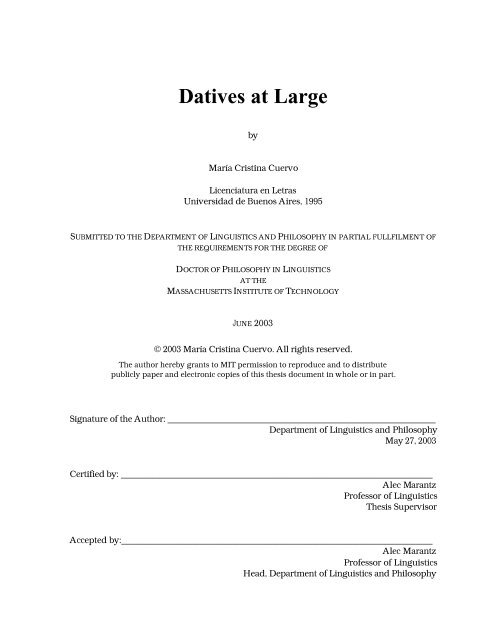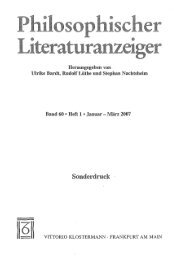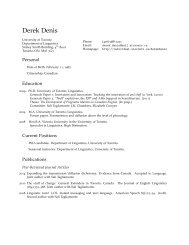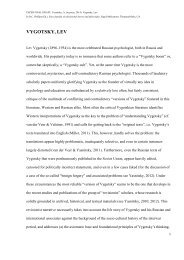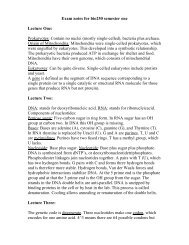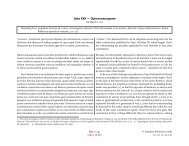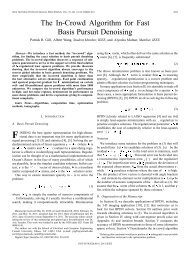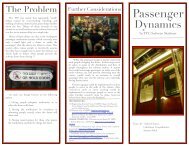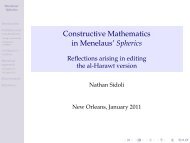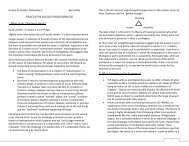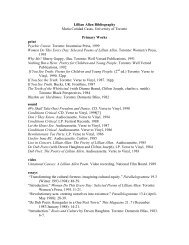Datives at Large
Datives at Large
Datives at Large
Create successful ePaper yourself
Turn your PDF publications into a flip-book with our unique Google optimized e-Paper software.
<strong>D<strong>at</strong>ives</strong> <strong>at</strong> <strong>Large</strong><br />
by<br />
María Cristina Cuervo<br />
Licenci<strong>at</strong>ura en Letras<br />
Universidad de Buenos Aires, 1995<br />
SUBMITTED TO THE DEPARTMENT OF LINGUISTICS AND PHILOSOPHY IN PARTIAL FULLFILMENT OF<br />
THE REQUIREMENTS FOR THE DEGREE OF<br />
DOCTOR OF PHILOSOPHY IN LINGUISTICS<br />
AT THE<br />
MASSACHUSETTS INSTITUTE OF TECHNOLOGY<br />
JUNE 2003<br />
© 2003 María Cristina Cuervo. All rights reserved.<br />
The author hereby grants to MIT permission to reproduce and to distribute<br />
publicly paper and electronic copies of this thesis document in whole or in part.<br />
Sign<strong>at</strong>ure of the Author: ____________________________________________________________<br />
Department of Linguistics and Philosophy<br />
May 27, 2003<br />
Certified by: ______________________________________________________________________<br />
Alec Marantz<br />
Professor of Linguistics<br />
Thesis Supervisor<br />
Accepted by:______________________________________________________________________<br />
Alec Marantz<br />
Professor of Linguistics<br />
Head, Department of Linguistics and Philosophy
ABSTRACT<br />
DATIVES AT LARGE<br />
by<br />
MARÍA CRISTINA CUERVO<br />
Submitted to the Department of Linguistics and Philosophy<br />
on May 27, 2003, in partial fulfillment of the<br />
requirements for the degree of Doctor of Philosophy in Linguistics<br />
This dissert<strong>at</strong>ion is a study of the syntactic and semantic properties of d<strong>at</strong>ive arguments. The<br />
main source of d<strong>at</strong>a is Spanish, where d<strong>at</strong>ive arguments can appear with all types of verbs,<br />
and can have a wide range of meanings: goal, possessor, source, experiencer, affected object,<br />
causee, loc<strong>at</strong>ion, benefactive, malefactive, ethical d<strong>at</strong>ive. The challenge for a theory of d<strong>at</strong>ive<br />
arguments, which form a n<strong>at</strong>ural class morphologically, is to explain both wh<strong>at</strong> they have in<br />
common and how they differ syntactically and semantically. I argue th<strong>at</strong> d<strong>at</strong>ive arguments<br />
have structural meanings, i.e., the meaning of a d<strong>at</strong>ive DP can be derived directly from the<br />
position in which it is licensed. To be able to predict the possible meanings of d<strong>at</strong>ive<br />
arguments, it is crucial to take into account the details of the syntactic configur<strong>at</strong>ion, which<br />
include the properties of the head th<strong>at</strong> licenses the d<strong>at</strong>ive DP and of the functional heads<br />
th<strong>at</strong> construct the event structure.<br />
D<strong>at</strong>ive arguments are not direct arguments of the verb; they are, like subjects, licensed<br />
syntactically and semantically by a specialized head. This argument introducing head, the<br />
Applic<strong>at</strong>ive, licenses the d<strong>at</strong>ive DP as its specifier and rel<strong>at</strong>es this DP to the structure it takes<br />
as a complement. The range of possible meanings of a d<strong>at</strong>ive DP is predicted from the range<br />
of possible complements an applic<strong>at</strong>ive head can take (i.e. a DP or a vP), and from the range<br />
of heads th<strong>at</strong> the applic<strong>at</strong>ive phrase can be a complement of. Applic<strong>at</strong>ive heads are also<br />
sensitive to the type of event expressed by the vP (e.g., dynamic or st<strong>at</strong>ive, activity or<br />
caus<strong>at</strong>ive). The theory provides a set of positions into which an applic<strong>at</strong>ive head can merge<br />
and license an argument DP, as well as the set of interpret<strong>at</strong>ions the argument can get in each<br />
position. The set of positions is universal, but languages can differ with respect to the<br />
positions into which an applic<strong>at</strong>ive head is allowed to merge. These predictions generalize to<br />
applied arguments in languages in which they are not marked by d<strong>at</strong>ive case (e.g., English<br />
and Bantu languages).<br />
Thesis Supervisor: Alec Marantz<br />
Title: Professor of Linguistics


